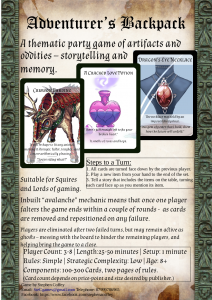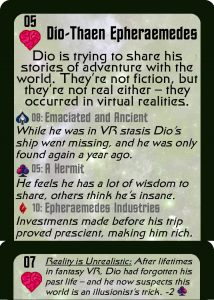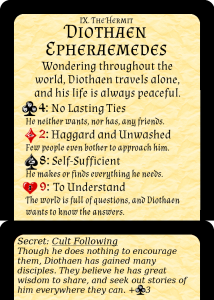A lot of this series has addressed implementing Extended Challenges in a general sense, but I am specifically developing them for 13th Age, so what are the key elements of 13th Age that can be tied into:
Backgrounds
In 13th Age non-combat challenges are made using skill checks, but they’re based on d20+(ability modifier+level)+a relevant background. These backgrounds are descriptive phrases such as “Trained as a Warlord by the Elf Queen”, “Undead Hunter” or “Crowd Favourite in the Gladiator Pits” – and are free-text, meaning that as a scenario writer it’s impossible to make a list of possible skill checks.
Additionally PCs are encouraged to only have 2 or 3 backgrounds, rather than using a larger skill-list as seen in D&D editions 2-5 – and any attempt to prevent repeated checks needs to take that into account.
So rather than considering re-use of the same background to be repetition, I’m going to define repetition as “Using the same combination of ability score and background as used on a previous successful check”. As for the prevention? I think it’s fair to kick the difficulty up by a notch; you’ve plucked the low-hanging-fruit for that combination, so using it again means you’re trying something harder.
Standardised Difficulties
The DCs for skill checks in 13th Age are highly standardised; being set based on the environment the encounter is taking place in, and always being multiples of 5. In 4e skill challenges had DCs that were, by default, set by the level of the party, but 13th Age is explicit about them being based on the environment/opposition.
So we’ll use the 13th Age chart when setting skill check DCs.
| \/Task/Environment> |
Adventurer Tier
DC |
Champion Tier
DC |
Epic Tier
DC |
| Normal task |
15 |
20 |
25 |
| Hard task |
20 |
25 |
30 |
| Ridiculously hard task |
25 |
30 |
35 |
As you can probably tell this isn’t actually very limiting – when designing an Extended Challenge the environment is likely already set, but that still gives the flexibility of picking whether the challenge is made up of Normal, Hard or Ridiculously Hard tasks.
As a rule I expect to use only “Normal” and “Hard” as the baseline for any extended challenge – most often Normal – but it seems like a good idea to give guidance on when to kick a check up a tier; should harder checks be a punishment for making silly choices, or an opportunity to achieve greater success at greater risk?
Personally I lean to the latter – the former could be a useful tool for GMs who find that their players suggest truly absurd uses of their backgrounds, but 13th Age is generally built on a strong foundation of “Assumption of Good Faith”, so it feels like such a use would go counter to the system philosophy.
Player Narrative Influence:
For an F20 game, 13th Age is particularly keen on player’s influencing the narrative, so to feed into that I’m going to add flexibility rules:
-
- Encourage players to create obstacles to be overcome, and opportunities that they’ll take advantage of, rather than putting the onus on the GM.
- Allow Temporal Flexibility – flashbacks to things that were prepared earlier.
Icon Dice
A significant portion of players’ narrative power in 13th Age comes through the Icon Dice, a set of 3+ d6, each connected to one of the 13 Icons, that each player rolls at the start of every session – and that may occasionally be rolled for special events – but the rules surrounding their exact uses are deliberately rather vague; they are primarily narrative tools and therefore they tend to be used differently depending on the style of each group.
But the kind of narrative influence they offer – ranging from the aid of another ally of your favoured icon to knowledge of your most hated icon’s secret signals – seems like it should fit in with the sort of situation that Extended Challenges are used to resolve. So I’ll be providing an advised usage for them – They allow a roll to achieve a double-success, but 5s also trigger the downside listed for failed risky attempts, even if you’re not using the risky attempt rules otherwise.
The Escalation Die
One of 13th Age’s tricks for exciting combat is The Escalation Die – a d6 that is added at the end of the first round, set to one, and increases by one each round.
It’s added to all player attack rolls, and serves to make combat more climactic; the obvious strategy of using your biggest spells to eliminate enemies right at the start – “going nova” – is made less optimal by the fact that holding those powers back lets you use them later when they have a better chance to hit.
But it’s explicitly not added to skill checks made during combat – so importing it into Extended Challenges and making it work for skills would be a somewhat strange change – which means no escalation die. But perhaps there’s another way to implement a similar feeling?
Actions that aid the whole party on all future checks can build up like the escalation die can, and encourage players to take more risks as the challenge goes on. This does suggest that perhaps any resource expenditure should still come with an element of risk – rather than expending dailies being a guaranteed bonus success, as I’ve been running them in my home game.
This isn’t even my final post
Last week I announced the post as probably penultimate… turns out that there’s significantly more to do before I can put together a final rule set. Over the next week I’ll be compiling the realisations I made while writing this in order to create a ruleset for Extended Challenges
P.S. thanks to everyone that’s been reading these, and especially those who’ve commented, writing them has really helped me think and having an audience makes writing much easier for me.
Please follow and like us:




